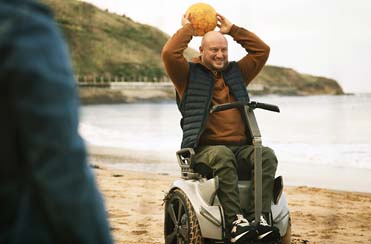Unfortunately, chronic pain in spinal cord injury patients is all too common. Research shows that about 70% of people with a spinal cord injury experience chronic pain, with some studies putting that number as high as 80%.

Image credit: Stefano Intintoli
In one study, one-third of those experiencing severely intense pain cited an impact on mood, functioning, and quality of life. If you are experiencing chronic pain, it may help to understand the kinds of pain you may be experiencing and gain some guidance on effectively managing chronic pain after a spinal cord injury.
Understanding pain after a spinal cord injury
There are two common types of pain: musculoskeletal and neuropathic.
Musculoskeletal pain
This is the kind of pain that everyone experiences. This type of pain is often in the back, shoulders, or wrists. It usually happens after physical stress or physical exertion like lifting, moving, and exercising. Immediately following your spinal cord injury, you would have experienced this due to the severe trauma to your body. However, once the body has recovered, an injury or repetitive stress on a body part can cause this type of pain. Pushing your manual wheelchair for a long time or partaking in strenuous wheelchair sports might cause wrist pain, for instance.
Neuropathic pain
This type of pain is much more complex and less understood in scientific circles. It also varies by individual. People often describe this as a burning sensation or feeling like being constantly poked with pins and needles.
Others say they feel an electric or cold sensation. This pain is usually felt at or below the level of your injury. Neuropathic pain is often difficult to trace to a single trigger or simple stimulus.
Pain researchers cite it as having a complex pathology related to spinal cord nerves that may have sprouted new, inappropriate connections. Other potential sources include lost integrity of myelin (a sheath around nerve fibres), or it could have something to do with changes to your body’s biochemistry.
Although there are many scientific theories about neuropathic pain and its origins, the bottom line is that it’s a real, sometimes intense, chronic pain after a spinal cord injury that is often accompanied by spasticity.
Managing chronic pain after a spinal cord injury
Minor musculoskeletal pain can be managed through conventional treatment, such as over-the-counter pain relievers and the rest-ice-compression-elevation (RICE) approach. Your doctor might prescribe prescription medication, surgery, or other treatments for more severe musculoskeletal pain.
Neuropathic pain, however, often requires a multidisciplinary approach. That means working with a medical team that may include several physicians specialising in pain, spinal cord injury, psychiatry, rehabilitation and occupational therapies, and other treatment areas.
An entire team of specialists can help you manage chronic spinal cord injury pain by:
- Treating the entire biology of your pain in a comprehensive way
- Addressing related psychological factors — stress, anxiety — to avoid the onset of depression
- Prescribing medications
- Exploring whether surgery or specialised pain therapies may help, such as nerve ablation or neurostimulation
- Helping you overcome obstacles that can cause pain or impact your quality of life
Although more research needs to be done to understand spinal cord injury and pain and improve the lives of those living with chronic spinal cord injury pain, the good news is that there are many options that will provide help. A combination of treatments may be most effective. Work with your medical team to find what works best to keep your pain to a minimum and improve your quality of life.
Do you have further questions? Get your SCI questions answered by the Navigator Team by sending us a message or contacting us on 0800 373 858.
References:
- Treatments for chronic pain in persons with spinal cord injury: A survey study - PubMed (nih.gov)
- http://sci.washington.edu/info/pamphlets/spasticity_msktc.pdf Dealing with Spasticity and Pain | Hollister US









